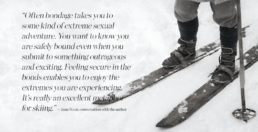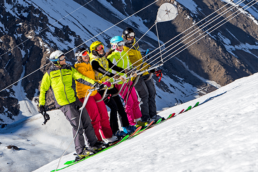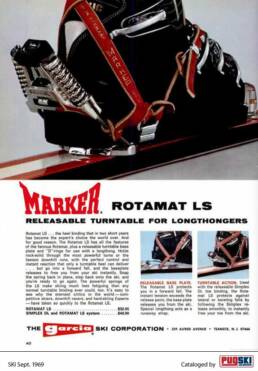The foot bone’s connected to the leg bone. The leg bone’s connected to the knee bone. The knee bone’s connected to the thigh bone.
In that treacly passage from the “Skeleton Dance” song, introduced in a 1929 Walt Disney short subject, lies a great truth about skiing: It is all about the connections.
In that spirit—strike the music!—the ski is connected to the binding, the binding’s connected to the boot, the boot’s connected to the body, the body’s connected to the chairlift, and the chairlift’s connected to a steel cable.
All that plus one more thing: Perhaps the greatest elements of our winter sport are the human connections—the chance meetings in the tram, the laughs at the bar at an après ski happy hour, the tall tales told at dinner, the memories shared by the fire on a snowy evening.
For skiing is really about all those things—getting tied to skis, struggling with tight boots, wearing tight ski outfits, being tied to lifts that haul you up the mountain. If Somerset Maugham had been a skier, his Of Human Bondage would have been a far different novel.
And it turns out that nutcrackers, va y vients, rope tows, and the like — we will come to all those things in time — have more in common with sexual bondage than you might think.

All this bondage—the skiing kind, not the sexual kind—has been connected to the technology of the sport from the beginning, even before the term “technology” existed.
And though skiing is intimately tied to nature, its ties to nature are a matter of technology. “Ski boots and bindings were intended to give a skier greater control over his skis,” the ski evangelist Stan Cohen wrote in his classic 1985 book Pictorial History of Downhill Skiing. “With the new bindings, a skier was attached more firmly (and safely) to his skis while the stiff, high-topped boots translated the slightest leg movements directly to its edges.”
The early bindings were tree roots, branches and animal skins tied to skis. The early boots were simple pieces of footwear bound together with laces. The early lifts weren’t lifts at all but were ski tows where the connection was between primitive gloves and a frayed rope. As skiing advanced—and it was a long march, mostly a traverse—so did the connections.
“The connections we take for granted today have to do with the modernization and industrialization of skiing,” E. John B. Allen, a Plymouth State University historian in New Hampshire and author of From Skisport to Skiing: One Hundred Years of an American Sport 1840–1940, told me. “In the early days all you had was a bit of wood and some sort of strap. All these connections came with the mechanization of skiing. It started in the late 19th century and accelerated. It caused the change from skiing as a folk occupation to a sport.”

Though skiing’s roots involved tree roots, the modern sport took form when the Norwegian innovator Fritz Huifeldt produced a binding that kept the heel mobile while keeping the toe in place. The first American patent for a releasable ski binding came in 1908 for “skee stirrups to prevent a fall which will produce serious results from accidental falls, it being the particular object to release the use of the skee.” By 1951, Cubco was producing a release binding with both a toe and heel piece.
As the years progressed various contraptions—you might think of them as girdles for the foot—emerged, some looking like beach sandals, others like watch bands, still more like the fasteners at the back of a baseball cap. Eventually adjustable heels, side panels, clamps and springs emerged. Later, metal cables provided diagonal tension. And then came ski brakes, which began as experimental elements but became standard by 1977.
But the principle was the same: bondage.
The Dovre cable binding and the Northland Micromatic binding were known as “safety bindings,” but the measure of safety they provided does not measure up to today’s standards. The Marker Rotomat, with its rear spring-release system and its rotating pedestal, won special notoriety for blasting apart, winning it the unfortunate nickname Explodomat. “Despite the Rotomat’s quirks, it was a technological miracle,” Allysun Bryden wrote in a study for the Aspen Historical Society that is an indispensable guide to the history of ski equipment. “Its plate binding had a steel surface that would rust and then stick together. As a result, the binding often failed to release at all, even when banged with a hammer.”
Often bondage takes you to some kind of extreme sexual adventure. You want to know you are safely bound even when you submit to something outrageous and exciting. Feeling secure in the bonds enables you to enjoy the extremes you are experiencing. It’s really an excellent metaphor for skiing. — Jane Boon, conversation with the author
Let’s put aside for a moment thoughts of the kind of black bondage high-shine crinkled leather buckle boots and focus on the kind of buckle boots you actually might buy at your local ski shop.
The buckle boots fashioned from synthetic materials that emerged around 1955 replaced the laced leather boots that were the mainstays of skiing for decades. The key was to provide comfort even while assuring the boot and foot were bound together—perhaps the most intimate of the bondage in the entire sport of skiing. “Today’s boots are still designed to provide support and rigidity to the foot while enabling the skier’s leg movements to be transmitted to the ski,” said Bryden.
The word connection is perfect here.
“When I fit a boot, I think ‘connection,’ because if your boots don’t fit, you’re having a miserable day and you might as well stay home,” said Dan Lewis of North Conway, N.H., who has been doing bunion stretches or toe stretches to ski-boot shells for 57 years. “You have to know the different heights, the different widths, to match with an individual’s anatomy: their calf musculature, their bunions, the size of their ankles.”
Boot manufacturers want to build boot molds that homogenize the fit in an effort to get as many different feet into a single boot. But the result is a form of bondage that requires the intervention of a facilitator: the boot fitter. “In a serious boot shop, he has to know which boot manufacturer makes a wide boot or a tight-fit boot,” said Lewis. “Then he has to heat the liners and make shell modifications to eliminate pressure points. It is time- consuming, but the boot is simply the most important part of your equipment. It’s a truly intimate connection.”
That very notion of intimate connections has been springing to life for four decades in the iconic Lange posters, where female models are in buckle boots but their outfits are deliberately and provocatively unbuckled. Over the years these posters have taken on the aura of the Sports Illustrated bathing-suit edition, raising a question that has hovered about those outfits: Just what kind of sports are they illustrating?
Skiing on a mountain slope and bondage in sex represent calibrated doses of thrill-seeking. Skiers and kinksters both rely on judgment, expertise, tolerance for risk and well-secured gear to get our hearts racing and our pupils dilated. At their best, both activities can be transcendent. At their worst, they can require an emergency room. —Jane Boon, conversation with the author
Now consider the bondage between skier and ski lift.
The first rope tow in the United States was bound to a hill on Clinton Gilbert’s Woodstock, Vermont, farm in 1934, powered by a Model-T truck engine. Another rope tow was spawned two years later in East Corinth, Vermont, and remains in operation at Northeast Slopes.
For the devotees of rope tows—athletes who are antiquarians—there is no reason to think about building back better. And the denizens of Northeast Slopes are feverishly devoted to their rope tow, powered by a six-cylinder engine in a rusty 1973 Dodge Dart with a spaghetti of connections that would leave Rube Goldberg dizzy.
Here’s how it works: A small sprocket comes up from where the seats once were installed. It is attached to a big sprocket in the center of the car that sits on the same shaft as four 18-inch pulleys. They, in turn, pull the rope and send it up the beginner slope. A separate row tow on the area’s more advanced slope is connected to a 1960 Ford farm truck where the rope emerges from the spot where the rear wheels once stood. It climbs the hill at a glorious high speed of 17 mph. These curators of a long-derided ride set a record of 27.63 mph in 2012.
But at any speed, it is the multiple connections that make it work.
“All of these connections are essential,’’ the area’s voluntary vice-president, Wade Pierson, who started skiing on cable bindings on a pair of steel-edge wooden skis at age six, said in an interview as he was cooking onions, ribs and kielbasa on a grill in the Killington parking lot after a morning of late-April spring skiing. “Without all of these bindings—they work like ski bindings—operating in unison, the rope tow wouldn’t go anywhere. That was true in 1934 and it’s true in 2022.”
Connection is fundamental, too, in Portillo’s famous sling-shot lift, known as a va y vient, French for “come and go.” It’s basically a Poma tow with multiple platters, producing an effect on the Chilean hill that one skier likened to “waterskiing uphill at 60 miles per hour.” Once again, the key is in the connections—and in one immutable rule: When the lift comes to a dead stop on a 25-degree hill, one skier holds onto his platter, allowing the others to depart. The final skier relinquishes his hold on the tow.

Then there are the “Nutcracker” tows popular in New Zealand. These are conveyances that attach to a hip harness and drag a skier up a hill. Three of these operate at the demanding Craigieburn ski area about a 90-minute drive from Christchurch, but they can be found scattered around the country, including at Ski Roundhill, which has a rise of 2,053 feet. Though its operation requires 90 kilowatts of power, it includes a control that allows the operators to shut it off when no skiers are in line to ascend the hill or are on the lift.
But those are novelties in the bondage business. Your everyday chairlift is the product of an elegant equipoise, with clamps connected to heavy-duty cables that actually allow the chairlift to migrate on the wire.
High-speed chairlifts have similar clamps but have a much larger spring mechanism; that’s because the chair actually leaves the cable at the loading and unloading stations. “There’s a mechanism that actually releases the grip from the rope,” Bender explained. “You can’t load a high-speed chair at the rate that rope is churning. The chair then moves to wheels that take the chair around so the skiers can get on. Then the chair is thrown back on the cable and the grip reattaches to the cable.”
In short: bondage, release, bondage.
Putting on your gear is a lot like foreplay. It is like when a lover ties you to the bed slowly and lingers on the ropes as they fasten your wrists in place. It is just like putting on your boots. And you don’t remove your boots until you’ve had your thrills. It’s like a post-orgasm ritual. —Jane Boon, conversation with the author
EPILOGUE: Whether on skis or boards, devotees of snow sports truly become one with the world in a form of bondage that has no equal in any other sport. And by doing so, they are an organic part not only of the mountain but also of the way the world works.
The El Malei Rachamim remembrance prayer has been a prominent feature of Jewish funerals for centuries. It speaks of dwelling in the heights and in the depths, and it asks that the deceased be “bound up in the bond of eternal life.” In skiing as in life, the bonds are the thing. They are everywhere.


